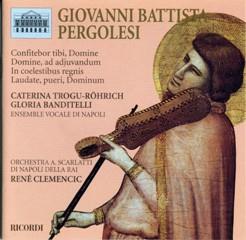Pergolesi - Motets (2020)
Pergolesi - Motets (2020)

Confitebor Tibi, Domine 01. I. Confitebor tibi Domine 02. II. Confessio et magnificentia opus ejus 03. III. Fidelia omnia mandata ejus 04. IV. Redemptionem misit populo suo 05. V. Sanctum et terribile nomen ejus 06. VI. Gloria Patri 07. VII. Sicut erat in principio Domine, ad Adjuvandum 08. Domine, ad Adjuvandum 09. Gloria Patri 10. Sicut erat in principio In Coelestibus Regnis 11. In Coelestibus Regnis 12. Alleluia Laudate pueri Dominum 13. I. Laudate pueri Dominum 14. II. A solis ortu 15. III. Excelsus super omnes 16. IV. Quis sicut Dominus 17. V. Suscitans a terra 18. VI. Gloria Patri 19. VII. Sicut erat in principio Caterina Trogu-Rohrich - soprano Gloria Banditelli - contralto Orchestra A. Scarlatti di Napoli della RAI Rene Clemencic - conductor
His family name was Draghi, but, having moved to Jesi from Pergola, the family was called Pergolesi, meaning “of Pergola.” Sometime after 1720 he attended the Conservatorio dei Poveri at Naples, where he earned a high reputation as a violinist. In 1732 he was appointed maestro di cappella to the prince of Stigliano at Naples and produced a Neapolitan opera buffa, Lo frate ’nnammorato, and a mass (probably his Mass in D). Both were well received. In 1733 his opera seria Il prigionier superbo was produced. But it was the comic intermezzo La serva padrona, inserted between the acts of Il prigionier superbo, that achieved success. In 1734 Pergolesi was appointed deputy maestro di cappella of Naples, and in May he went to Rome to direct the performance of his Mass in F. His subsequent operas met with only occasional success. His health began to fail, and in 1736 he left Naples for the Franciscan monastery at Pozzuoli, near Naples, where he finished his last work, the celebrated Stabat Mater. He died in extreme poverty at age 26 and was buried at the cathedral at Pozzuoli.
When Pergolesi died, his fame had scarcely spread beyond Rome and Naples, but later in the century it grew enormously. The success of La serva padrona was largely posthumous, and it reached its peak after its performance in Paris in 1752. There it led to la guerre des bouffons (“the war of the buffoons”), with musical forgers vying to produce spurious works of Pergolesi, leaving some uncertainty about the authenticity of works attributed to him. Some of the works credited to Pergolesi by Igor Stravinsky in arrangements he made for his ballet Pulcinella (1920) are among those of doubtful authenticity. ---britannica.com
Krotko żyjący Giovanni Battista Pergolesi (1710-1736) był do pewnego wiosennego wieczora w 1919 roku prawie zapomnianą postacią. Wtedy to impresario, Sergiusz Diagilew, skłonił Igora Strawińskiego do skomponowania baletu opartego na muzyce tego kompozytora. Strawiński spojrzał ponoć na nuty i bez reszty zachwycił się tą muzyką. Jego inspiracja znalazła wyraz w muzyce do baletu Pulcinella, który, jak twierdził później Strawiński, „stał się symbolem narodzin całej mojej późniejszej muzyki”. Pergolesi należał do czołowych kompozytorów włoskiej opery komicznej pierwszej połowy XVIII wieku. Urodzony w rodzinie szewców, szybko zapadł na zdrowiu. Przez całe życie chorował na gruźlicę, miał również problemy z chodzeniem. Niedostatki zdrowotne rekompensowały jednak niecodzienne uzdolnienia muzyczne, które umożliwiły mu samodzielne utrzymywanie się w Neapolu podczas studiów w tamtejszym konserwatorium. Zaraz po ukończeniu szkoły w 1731 roku Pergolesi skomponował swoją pierwszą operę, La conversione e morte di San Guglielmo. Dzieło spotkało się wprawdzie tylko z częściowym sukcesem, jednak na tyle dużym, by Pergolesim zainteresował się książę Neapolu, Fernando Colonna Stigliano, który zatrudnił młodego kompozytora na swoim dworze jako maestro di capella. Trzęsienie ziemi, które dotknęło Neapol w 1732 roku, i związana z tym prośba arcybiskupa o skomponowanie przez Pergolesiego mszy pokutnej zaowocowało serią kompozycji religijnych na głosy solowe, chór i orkiestrę z głównym utworem – Stabat Mater powstałym w 1736 roku. Choć w świecie operowym nie dorobił się Pergolesi pełnego uznania i ponadczasowej sławy – podczas premiery opery L’Olimpiade w 1725 roku ponoć jeden ze słuchaczy rzucił w Pergolesiego pomarańczą – tak w muzyce kościelnej odniósł niezaprzeczalny sukces. Zmarł w marcu 1736 roku na gruźlicę. Pochowany został w kaplicy katedry Puzzuoli. ---rmfclassic.pl
download (mp3 @320 kbs):
yandex mediafire ulozto gett solidfiles bayfiles








